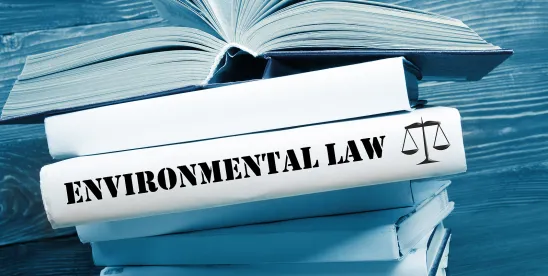Two Powerful Legal Systems, One Messy Collision
The bankruptcy process, governed by the Bankruptcy Code, is all about giving struggling businesses or individuals a fresh start. Laws governing environmental liabilities, on the other hand, ensure that polluters pay for the damage they’ve done to people and the planet. But what happens when a business facing such liabilities files for bankruptcy?
Bankruptcy Basics: Fresh Starts and Fairness
Robert Richards, partner at Dentons US LLP, explains that bankruptcy law, especially under Chapter 11, is designed to reorganize troubled businesses or sell them as going concerns. The goal is to preserve value and or distribute it fairly among creditors.
But fairness in bankruptcy isn’t always aligned with environmental priorities. In some cases, businesses may try to use bankruptcy to wipe away environmental obligations.
“Just because a company files for bankruptcy doesn’t mean they can wipe the slate clean,” states Anthony Cali of Stinson LLP. “But it does open the door to rethinking how environmental liabilities are managed.”
Environmental Law: The Polluter Pays
As Laura Coordes of Arizona State University notes, environmental law operates on the principle that the polluter should bear the burden of cleanup. Whether it’s hazardous waste regulated by the Comprehensive Environmental Response, Compensation, and Liability Act (CERCLA) (also known as the Superfund law), contaminated groundwater regulated by the Resource Conservation and Recovery Act (RCRA), or pollutants covered under the Clean Water Act, environmental statutes impose strict responsibilities. Sometimes, even past owners or operators can be on the hook. Importantly, these responsibilities often don’t just disappear in bankruptcy.
Filing for Bankruptcy? Get Your Environmental House in Order
When a business with environmental liabilities is considering bankruptcy, disclosures are key. As Jeffrey Schwartz of Much Shelist, P.C. notes, the bankruptcy forms themselves require detailed information about any hazardous sites, government notices, and pending environmental lawsuits.
Timing matters too. Claims for environmental damages that arise before bankruptcy might be discharged. But post-bankruptcy obligations, especially those tied to ongoing operations, might stick around.
Stakeholders: More Than Just Debtors and Creditors
Understanding who’s at the table is essential to negotiating any path forward. In environmental bankruptcies, the list of stakeholders grows. Besides lenders and trade creditors, the mix may include:
- Tort claimants harmed by pollution
- Adjacent landowners
- Government regulators (the Environmental Protection Agency, state agencies, and tribal authorities)
- Other ‘potentially responsible parties’ (PRPs)
The Automatic Stay and Its Limits
One of bankruptcy’s core protections is the automatic stay, which halts most legal actions against a debtor. But there’s an important carve-out: the police power exception.
The police power exception lets government agencies continue enforcing environmental laws, even after a bankruptcy filing. However, they can’t collect monetary judgments without court permission. Courts often have to draw a line between regulatory enforcement, which is allowed, and debt collection, which is not.
What Happens to Contaminated Property?
Debtors may want to sell, abandon, or reorganize around contaminated sites. Each option carries legal pitfalls.
Under Section 363 of the Bankruptcy Code, businesses can sell assets ‘free and clear’ of claims, but environmental liabilities may survive the sale. Buyers need to beware, especially if courts find them to be ‘successors in interest.’
Abandonment isn’t always allowed either. The Supreme Court’s decision in Midlantic v. New Jersey blocks debtors from abandoning properties in contravention of a state statute or regulation reasonably designed to protect the public health or safety.
Environmental settlement agreements do, however, provide a practical solution.
As Schwartz describes, these often involve transferring contaminated property into custodial trusts funded by the debtor, its lenders, or insurers. In exchange, the government may offer a covenant not to sue and contribution protection, meaning the debtor won’t face future liability for cleanup. But the government won’t settle unless it sees real value. That’s why showing that a business can’t afford to clean up, and that a trust is the best alternative, is essential to making the case.
Claims and Contribution Fights
Environmental cases also raise complex issues around claims for contribution. What happens when one PRP pays more than its fair share and wants reimbursement from a bankrupt co-polluter?
Under Bankruptcy Code Section 502(e)(1)(B), contingent contribution claims can be disallowed, but only under a strict three-part test. Still, PRPs may monitor cases closely and even file claims on behalf of the government if necessary.
Can Bankruptcy Erase Environmental Debts?
Sometimes. If a government’s claim is just a right to payment for past damages, it may be discharged. But if it’s a demand for ongoing cleanup, like under RCRA, it might survive the bankruptcy.
The line is not always clear. In Ohio v. Kovacs, the Supreme Court said a monetary cleanup order could be discharged. But in later cases like Apex Oil, courts ruled that ongoing injunctive orders (even costly ones) weren’t dischargeable.
Bankruptcy and Environmental Compliance: Complex, Costly, but Possible
“There’s an inherent tension between the two [bankruptcy law and environmental law],” observes Schwartz, “but courts are trying to strike a balance. A bankruptcy filing doesn’t give a business a free pass to ignore the law, and companies still need to comply with regulatory orders, especially if their pollution poses ongoing public health risks.” However, solutions are possible with the proper attention and counsel.
To learn more about this topic view Bankruptcy Intersections: Environmental. The quoted remarks referenced in this article were made either during this webinar or shortly thereafter during post-webinar interviews with the panelists. Readers may also be interested to read other articles about business distress.
This article was originally published here.
©2025. DailyDACTM, LLC. This article is subject to the disclaimers found here.




 />i
/>i
